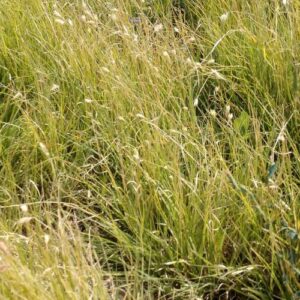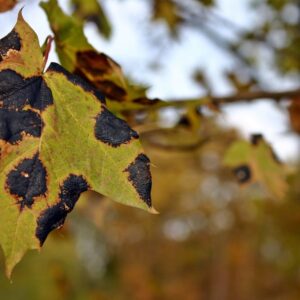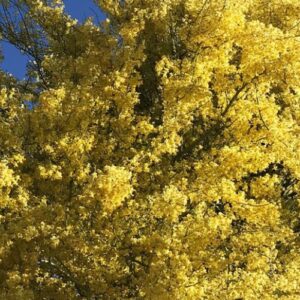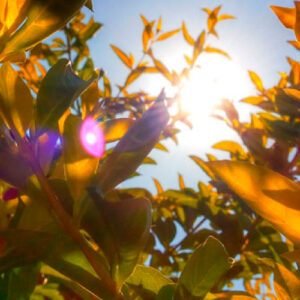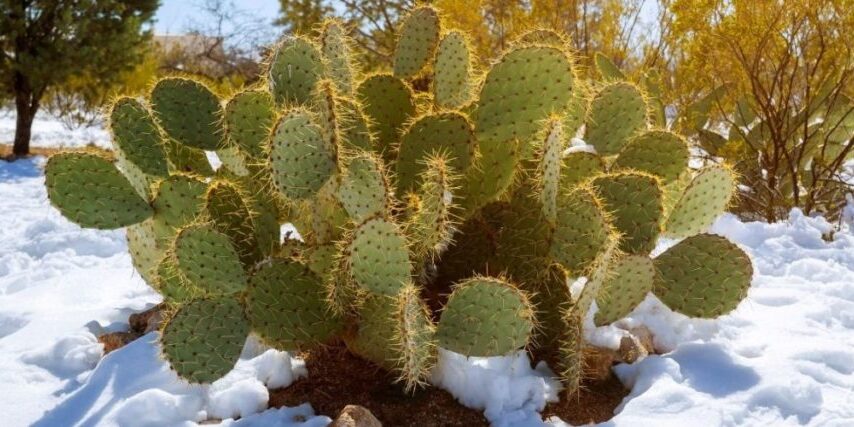
Winter weather in Phoenix and Anthem can be pleasant, but there are some winter issues that can damage your trees and landscape plants. In this article, we walk through some common winter problems for trees, shrubs, and plants. Learn how winter weather occurrences such as frost, snow, and freezing temperatures can cause sunscald, desiccation, and other injuries to your landscape plants.
Snow on Trees & Shrubs
When you talk about “walking in a winter wonderland” in the Phoenix and Anthem areas, it really means that we have some beautiful, warm weather during the holiday season. Though there have been some (rare) occurrences of snow in the Phoenix area, snow usually only falls at higher elevations. However, it’s good to be prepared in case a rare snowfall occurs.
Here’s what to know if we get a snowfall -
If enough snow accumulates to coat your plants or trees, the weight of the heavy snow may cause branches to bend or even break.
The important thing is to leave everything alone. As tempting as it may be to brush the snow off, you may do more harm than good.
Within a few hours, the snow should melt, providing needed moisture to the area.
Once the snow has melted, check your trees and plants for any broken branches. You may have to do some selective pruning if some of the smaller branches are broken but hanging in place – but only if you can reach them from the ground. If any larger (or higher) branches are damaged, call in a tree service professional.
Frost Damage to Plants
As with most kinds of damage, it is more helpful to prevent the damage than to try to treat the damage afterward. Due to the fluctuating winter temperatures in the desert, it can be warm during the day but much colder at night.
Check the Overnight Temperatures
Make it a habit to check if the temperature is forecasted to reach 35 degrees or lower overnight in your area. Thanks to microclimates, the temperature can vary across a city and even in different sections of your yard. This means that even if the temperature reading at your thermometer reads 35, it may be below freezing for some of your plants.
How to Protect Your Trees and Plants from Frost Damage
Once you know that frost is a possibility, there are some things you should do –
- Cover your frost-sensitive plants with a breathable fabric such as burlap, frost cloth, or cotton to protect them from the cold.
- Ensure that your plants and trees have been well-watered (yes, it does help!).
- Bring small potted plants onto a porch or into a garage to provide some short-term protection.
- Cover the arms of your cacti with Styrofoam cups, knitted or fabric hats, or frost cloth. Do not use plastic cups!
- Cover young trees, when possible, with a frost cloth or something that reaches to the ground.
- Christmas lights that produce heat (not LEDs) can be used to prevent frost damage in trees and is a common method of frost protection for citrus trees.
By the morning, you should be able to remove your frost protection and allow the plants to warm up with the sun. You may need to repeat the covering and uncovering of plants each day until the threat of frost has passed.
If any of your plants or trees do suffer from frost damage, wait until spring to prune off the damaged areas. The damaged areas not only provide protection to the rest of the plant, but they may recover once warmer weather returns.
Deep Freeze Damage to Trees
Frosts are more likely to occur than freezes in the Phoenix area. Temperature can change much more quickly in dry air than in humid air, which is why our daytime temperatures can vary so widely from nighttime temperatures.
While frosts last a few hours, freezes are much more severe and can last for several days. They are not common in southern Arizona, although they’re more frequent in states such as Texas or Florida.
If there is a freeze in southern Arizona, there is not a lot you can do to protect your trees. Following the frost protection steps will help, but deep freezes that last several days will do some damage.
Citrus and other fruit trees are the most likely to suffer severe damage; you can learn how to protect citrus trees in this handout from the University of Arizona Cooperative Extension.
Severely damaged trees should be assessed in spring by a tree care professional to see if any treatment options are possible.
Winter Sunscald on Trees
If you have a hardwood tree with thin bark and notice bark discoloration, sunken tree sections, or areas of the bark with vertical cracks, your tree may be suffering from sunscald. As with many winter injuries, the damage may not become visible until the spring.
Sunscald happens when trees with thin or sensitive bark (such as citrus trees) are suddenly exposed to the sun. This most often happens if a section of the tree that was previously shading the trunk is pruned away. But it can also happen if a shade cloth is taken down, a larger tree is removed, or if anything that was previously shading the tree is suddenly no longer providing protection from the sun.
The light doesn’t have to come directly from the sun; light-colored surfaces such as block walls or buildings can reflect sunlight onto sensitive trees.
Trees with west or south exposures are the most likely to be affected by sunscald, which is why it is sometimes referred to as “southwest injury.”
If you can't avoid removing the item that was shading the tree, consider wrapping the tree's trunk for the winter months. Just don't forget to remove it in spring. You can also help trees by painting the exposed trunk with white (or another light color) latex paint diluted 50/50 with water.
One of the reasons that sunscald can be dangerous for a tree is that wood beetles can enter through the opening and cause more damage.
Desiccation or Winter Burn
When the weather is both cold and dry, plants can be prone to desiccation or drying out. Also referred to as winter burn, desiccation is a common winter problem when the cold winds dry out an area so much that the plant can’t draw up enough water from the (possibly frozen) soil.
Desiccation affects evergreen trees and shrubs and is most noticeable in the spring, when leaves or needles become dry and brown.
The best way to prevent desiccation is to ensure that your plants, shrubs, and trees have enough water when the ground is not frozen. This can happen more frequently in raised beds, container gardens, or sections of your yard that are more susceptible to freezing temperatures.
Branch Dieback
When a section of a tree freezes to the point of no return (you’ll know for certain when it doesn’t produce new leaves or buds in spring), it is referred to as branch dieback or winter dieback.
Even though part of your tree has died, that doesn’t mean that the entire tree is doomed. Sacrificing one branch or section is a way that the tree protects itself from cold temperatures.
Once you are sure the branch has died, contact Titan Tree to schedule a professional tree pruning to remove the dead sections and to check over the rest of your tree.
Preventing Winter Tree Damage
Most winter damage that occurs in the Phoenix and Anthem areas is preventable. Just follow these simple steps to keep your trees, shrubs, and landscape plants safe during the winter:
- Keep your plants and trees well-watered
- Place a layer of mulch around any frost-sensitive plants or trees (but make sure it’s not touching the trunk!)
- Wait to prune frost-sensitive plants and trees until spring
- Cover or otherwise protect sensitive plants when temperatures drop to 35 degrees Fahrenheit
- Wrap any trees that might suffer from sunscald damage, especially if new sections are suddenly exposed to the sun
- Call in a professional if you notice significant damage or aren’t sure how to protect or treat your trees
While the Phoenix and Anthem areas usually have mild winter weather, it’s still important to be prepared for some winter damage. By following a few extra steps to prevent damage during colder weather, you can ensure that you have a healthy and vibrant yard all year long.
See Our Latest Articles
More Articles Like This

Titan Tree Care is a full-service tree care company located in Anthem, AZ and serving all of North Phoenix. We offer a wide range of services to meet your tree care needs, including tree and palm trimming, tree pruning, tree removal, stump grinding, and more. We also offer insect or disease treatments and fertilization services. We are dedicated to providing high-quality, safe, and effective tree care services to our customers and work hard to ensure that your trees are healthy and look their best.




